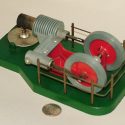This Stirling cycle engine, produced by Solar Engines, Phoenix, AZ, was likely sold by PM Research, Wellsville, NY. Stirling engines were invented in the 1800s, but are still being looked at today as potential sources of green energy. Requiring only a different temperature on either side of the displacer, they can run on as little as the heat from a cup of coffee. Though not producing a lot of torque, in places where geothermal heat, solar heat from a parabolic mirror, heat from burning sawdust or natural gas or other source is available, they can run without any other fuel source. They have been used for everything from running a room fan from the heat of a candle flame, powering generators or pumps in the field from the heat of burning gas or other fuel to more modern applications as new lightweight materials and other advances keep the interest of scientists.
Power for a Stirling engine is provided by the movement of air from one side of a displacer piston to the other as the air is heated on one side of the piston and cooled on the other.
Accompanying this engine was an instruction manual and a book on Stirling engines by Andy Ross that explains how the Stirling cycle engine works. For more, visit the PM Research website where this engine is available as “Solar #1.”


